
I usually have reservations about purchasing audio equipment from non-audiophile specific markets, but curiosity got the best of me. I won this amp on Ebay and picked it up from the seller's apartment in NYC. This nice person set it up with a pair of Signet SL250s and played some Sonic Youth to demonstrate that the amp at worked as described. As a Generation-X slacker, I approve of this personalized type of demonstration :)
The citation was, however, considerably more beat up than the ad ebay described, most notably the two 3/8" holes drilled into the top of the chassis that were hidden by the input tubes in the photograph. I believe these holes were drilled for input potentiometers. Of course, I didn't notice the holes were "unauthorized" until I got home.
Looking inside the unit told a similar story as the exterior: the builder of this kit sucked at soldering, turning the turret posts into traffic pylon shaped blobs of solder. The guitar amp tech who repaired the bias supply & nuked output tube socket also had questionable soldering skills...at least the tech was sensible enough to ease up the cathode current a bit by installing 3.9ohm cathode resistors.
I paid about as much as one would pay for a Citation V in average to good condition, but with the addition of one thing - the tube cage! The tube cage was somewhat dented and beat up but the relative rarity of it made the transaction worth it. I have seen other Cit Vs with fabricated "half" cages, but the correct Citation V cage covers the entire unit from front to rear and has square perforations like the Citation II cage. A cage is a necessity in my house because of the cats, but it also does a fine job of hiding the 3/8" holes.

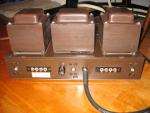

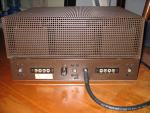
Being a professional tech has an advantage; I don't have to pay someone else to correct the amp's problems. This amp is for me during my free time, so I need only consider the investment in parts and not time or resources. I am also familiar with my work and hold high standards in neatness and quality of repairs.
If you are one of those unfortunate non-technical type mortals who would like to own a vintage Citation then you must do three things:
- Locate a Citation
- Find a tech who you can trust - knowledge of tube audio is a plus, but insist on quality work more-so because you will hear it if it's not.
- Expect to pay almost as much (or more) for parts and labor as for the unit itself.
So is it worthwhile? Is this as good as or better than a new tube amp for the same money invested? Yes...yes it is!
The Harmon Kardon Citation V amplifier was ahead of it's time because a signifigant amount of thought and engineering talent was utilized to make it perform to it's highest potential. Some of the very design concepts we consinder in modern high-end amplifier designs such as power supply bandwidth, impedance, circuit symmetry, simplicity and component quality enabled this amp to be a serious competitor to the Macintosh MC-240 for about half the price. The big deal with the Citation series tube amps is that the output transformers were designed for a wider bandwidth than their contemporaries which, in many ways, make this a suitable amp for the digital age. The Cit V is not a radical a design like the Cit II. The V is based on the Williamson amplifier, using 12BY7 pentode video tubes on the input, followed by 6FQ7 long tail pairs driving 7581 output tubes. Stu Hegeman (as far as I know) is not credited for designing this amp.
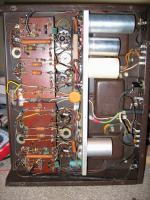
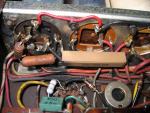


Here's what's been done so far:
- Replaced power supply caps using the SDS Labs Citation V board. The boards were not available when I built this, so I etched the boards myself thanks to Sheldon's circuit board template. The board works fine with a few adjustments here and there.
- Replaced 12ga upgrade line cord with 16ga line cord
- Replaced all output tube sockets and bias resistors.
- Replaced input tubes with NOS JAN 12BY7.
- Replaced Sovtek tubes with a mathched quad of Svetlana 6L6GC.
- Replaced input jacks with cheap-o gold plated RCAs. Also replaced input wire with Kimber TCSS twisted pair and re-arranged the input grounding scheme.
- Added the missing 1M ohm input resistor.
At this point the amp was safe (grounded chassis) and as close to renewed as it was going to be, so a listen was in order...it sounded ok. Not terribly resolved. The bass took some time to develop (power supply break in) but it became fuller. It had a three dimensional quality that was slightly forward, but with excellent depth. Soundstage well beyond the width of my NHT 1.5s. Loud complex passages were noticeably compressed & confused at all frequencies through 8 ohm speakers from the 4 ohm tap, and was still detectable at the 8 ohm tap. Bass was not as strong as one would expect from such large OPTs.

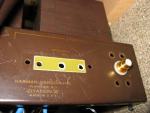

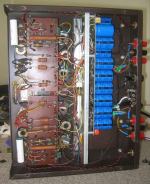
One evening I noticed that the Svetlana 6L6GCs had glowing plates. I reinstalled the Sovtek 6L6WGC and ordered a Jim McShane power supply kit with the choke upgrades well as a few other things. The Svets glowed red even with the McShane power supply, so I also ordered a quartet of SED/Winged-C 6L6GC. I tacked in a .68uf screen bypass and new coupling caps based on the McShane Citation V cap kit, and it immediately made the bass more satisfying and solid.
More stuff done:
- Wired remote device power activation circuit (ok, a lightswitch & AC outlet)
- Installed McShane Level II power supply
- Rewired the amp with 16 & 18 ga silver plated copper & teflon wire
- Installed new gold plated 9 pin sockets
- Reconfigured the stock grounds into a star grounding scheme
- Twisted pair heater wires
- Power supply lines were separated so that each channel had the same length of wire and the same number of solder connections and nodes
For this project I tried a couple of tweaks that I've thought about trying over the years. The effective mods stayed, and lessons were learned about the less effective ones. High performance audio is all about the little things, the thought, care, creativity, and the personal investment.
Needless to say, changing the power supply so entirely & rewiring made quite a difference in the amp. It became much smoother, more round sounding, perhaps a bit more lush (coupling caps, no doubt). There was definitely a greater sense of depth and of soundstage width. The amp now held on to complex, dynamic musical passages without getting confused or congested. The sound was warmer with a touch less transient snap than before, still, the overall dynamics were much better. Still not the last word in detail and doesn't have the bass I was expecting, but overall the sound is quite balanced and pleasing to listen to...with Sovteks no less!


Final touches:
- Small value capacitors
- McShane Citation V cap kit
- Upgrade signal path resistors
- Replace signal wires with Silver/OFC/Teflon and/or solid core silver/Teflon wire
- Few more tweaks
I gave up on agonizing over caps that I wanted to use, so I left the choice to the expert. Many of the caps were brands/types that I would never have considered because of their lack of audiophile pedigree, but the truth is in the listening...
This amp sounds fantastic! There is now a transient snap, a punchiness that has replaced the rounded and lush sound. The best way I can characterize the Citation V is of a tube amp that strives to be more than a tube amp. This is a very balanced, fast, and clean sounding amplifier that leaves only faint traces of common tube characteristics like over-airiness, sweetness, weak bass, and limited bandwidth. The SED output tubes are superb - harmonically rich and authoritative. I love it!
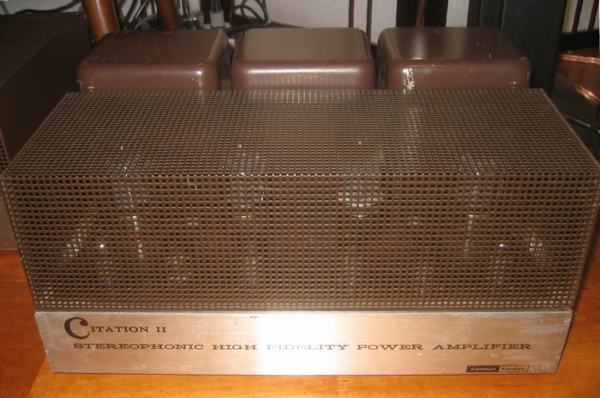
Page created by James L Woodley © 2005 Page last updated 24 February 2020